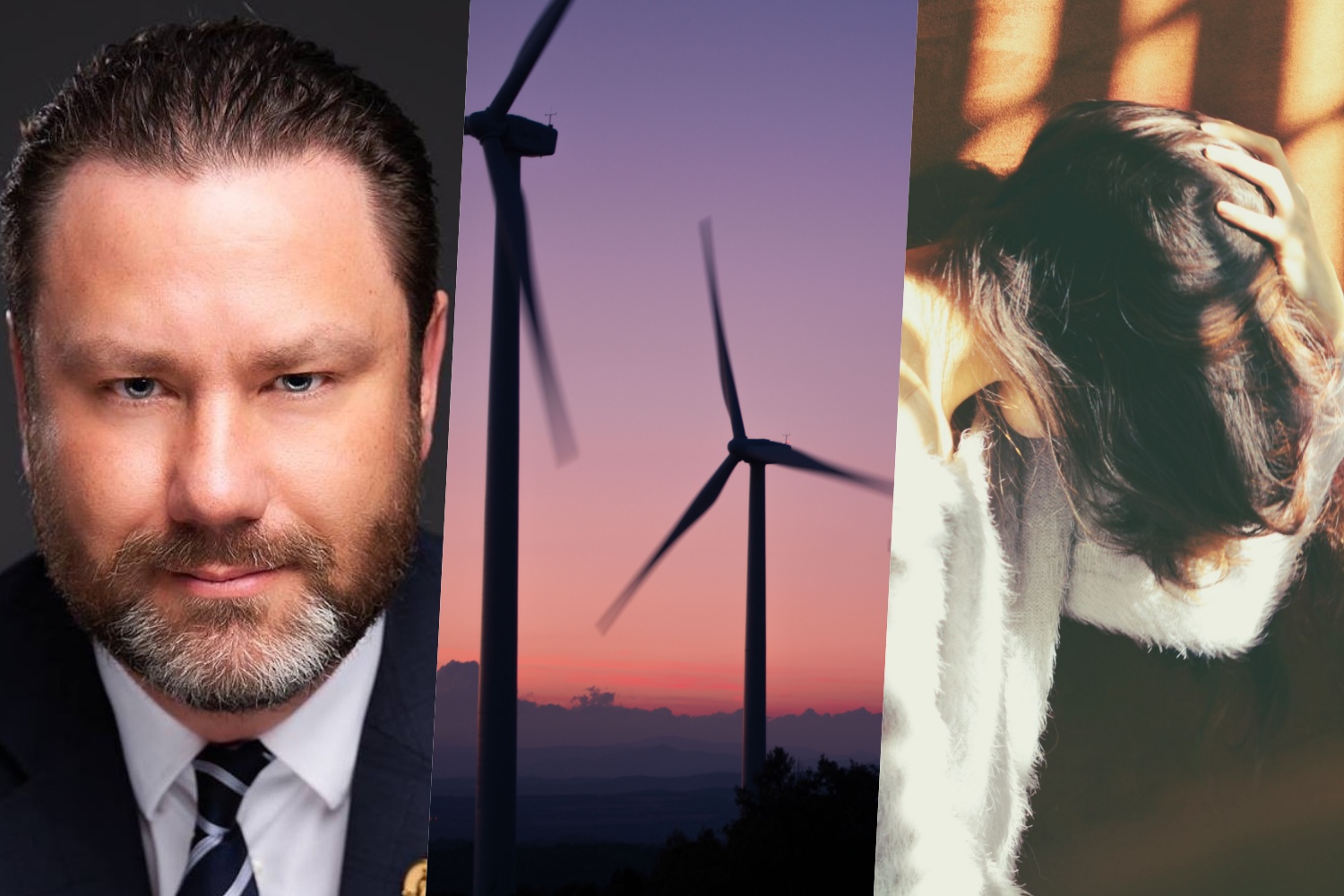While Premier Danielle Smith of Alberta has not hesitated to state her reservations on wind turbine plants,1 MLAs representing those rural communities who will be directly impacted have been curiously silent — until now.

Scott Cyr of the Bonnyville-Cold Lake-St. Paul riding took direct aim at wind turbines in a thorough submission to the Alberta Utilities Commission (AUC). The letter dated November 29th, and copied to Wind Concerns, acknowledges what wind turbine victims have been saying around the globe: these things hurt people and animals.
While applauding the AUC for its pause on approving renewable energy projects, Cyr warns:
Studies and court decisions have highlighted serious negative health effects for people residing within up to 10 kilometers of wind turbine plants, primarily due to ‘noise’ emissions. These health concerns, along with the potential for negative external effects on local communities, add another dimension to the renewable energy debate.
November 29, 2023, Submission to the AUC
Cyr links to a Finnish pilot study in 2019 that concludes:
The harmful or severe symptoms were clearly more common less than or about 15 kilometers from wind turbines than further away.
“The health effects of wind turbine infrasound based on its propagation on the people in the surroundings of wind turbinesin Finland”, 2019; suomenymparistoterveys.files.wordpress.com
(Note: it is not clear why Mr. Cyr cites 10km when the study found “severe symptoms” to within 15km of wind turbines. We have reached out to his office for comment at the time of publishing.)

As we have reported here, research going back as far as 2009 has linked wind turbines factories with adverse health effects2 under the banner “wind turbine syndrome” (WTS). As Møller et. al. concluded in their study, “It is thus beyond any doubt that the low-frequency part of the spectrum plays an important role in the noise at the neighbors.”3 The “noise” referred to here is the inaudible portion of the frequencies known as “infrasound’ that is felt more than heard leading to symptoms in some of headache, painful pressure on the ears, dizziness, weakness, tachycardia, tinnitus, nausea, nosebleeds, insomnia, visual blurring, panic attacks with sensations of internal quivering to more general irritability, etc.
As we reported recently, the wind industry is in full denial mode, despite the evidence, testimonies, and successful court cases that acknowledge WTS. Elementary Energy (EE), in a recent letter through their legal firm, wrote the families near Elk Point in Cyr’s constituency where massive 207m towers are being proposed next to residences. EE claimed that ‘wind turbines do not pose a risk to human health.’
“They’re either lying or they’re invincibly ignorant,” says Mark Mallett, Wind Concerns Editor in Chief.4 “We have produced not only evidence of widespread harm but the science to back it up. It’s very encouraging to hear a politician acknowledge these serious health concerns, finally.”
Cyr’s letter also states that “the extensive land use required for large-scale wind projects is alarming, potentially leading to the permanent alteration of prime farmland and natural landscapes.”
This contributes to the loss of prime farmland at alarming rates, an issue that must not be aggravated by poorly planned and irresponsibly executed green energy projects, particularly those that are heavily subsidized without delivering on their environmental and efficiency promises.
Scott Cyr, November 29, 2023, Submission to the AUC
Listing a host of negative environmental impacts on soil and its constituents, Cyr goes on to cite studies showing that property values take a big hit5 — something the wind industry also denies.
These green energy projects usually negatively affect the land values of the properties around them, adding another layer of concern for local residents and landowners.
Ibid.
Another key point in Cyr’s submission to the AUC is exposing what he calls “heavily subsidized” projects with questionable motives.
Some corporations are constructing green energy projects without the intention of operating them, instead aiming to obtain green tax credits or to artificially enhance their environmental reputation for PR purposes. This practice raises questions about the sincerity and effectiveness of such projects.
Ibid.
After calling for “green energy-restricted zones around environmentally sensitive areas and areas of natural beauty,” Cyr also urges the AUC to “implement a policy requiring green energy projects to submit comprehensive reclamation plans, akin to those required for oil and gas initiatives… it’s crucial to establish mandatory reclamation security requirements for these plans.” Presently, the province is footing the bill for some 12,500 orphaned oil well sites,6 something Premier Smith said she wants to avoid with wind turbines.1
Finally, Cyr demands that rural Albertans finally get a say in the renewable energy approval process as it’s they who ultimately bear the burden of these industrial projects.
We respectfully request that the consultation and investigation process be open and transparent, with significant involvement of the rural public in discussions about green energy projects.
Ibid.
“As it is, rural Albertans, including the municipalities, have little to no say in what happens to their communities and landscapes,” says Mallett. “And since Alberta is a free market, we now have green corporations all around the world clamoring to get their carbon credits on the backs of farmers and acreage owners whose property values plunge or their health craters when these wind projects roll in. Unless the Premier and her cabinet quickly enact legislation that protects rural Alberta, this province’s landscape will be changed forever.”
Says Cyr, “The AUC has a responsibility to the environment, but that responsibility does not end there. We need to ensure that future generations are not burdened with decisions we make today.”
But those burdens begin with the present generation — and time is of the essence. The pause on renewable energy projects ends on February 29th, 2023, at which point, several wind projects could potentially be unleashed on the province. Protections have to be put in place now.
It’s about time that politicians began to acknowledge that not all renewable energy is “green” or environmentally friendly. Wind factories are, in fact, the antithesis of good environmentalism. Cyr gets it. But will the rest of his government before it’s too late?
- see here[↩][↩]
- cf. Wind Turbines and Health: The Studies[↩]
- Low-frequency noise from large wind turbines“, 2010[↩]
- see The Wind Industry Said What?[↩]
- cf. Property Values: Gone With the Wind[↩]
- as of August 1, 2023; cf. orphanwell.ca[↩]
Wind Concerns is a collaboration of citizens of the Lakeland Alberta region against proposed wind turbine projects.



Thank you as I have been saying this for years are we really looking at things or is it just a rush by the federal governments to go green! Plus look at how many birds they kill!
I read the Finnish study. The 10 versus 15 km disparity is because wind can ‘push’ the infrasound waves farther downwind, just as wind affects audible sound waves. So, if there were no wind, the danger zone would be 10 kms. Prevailing winds would extend it to 15 km downwind. So, in southern Ab where I live, the prevailing west wind would extend the danger zone to 15 km to the east, but also intermittently in other directions in accordance with the wind direction that day. Also, it is logical that stronger winds would increase the range and severity of the effects, meaning chinook winds might significantly magnify the effects. However, the study does not address this, so further research would be needed for scientific confirmation.
I am happy to see that some of our leaders are stepping up to protect our land and most importantly the people living there. I’d like to see more of this! Definitely a step in the right direction.